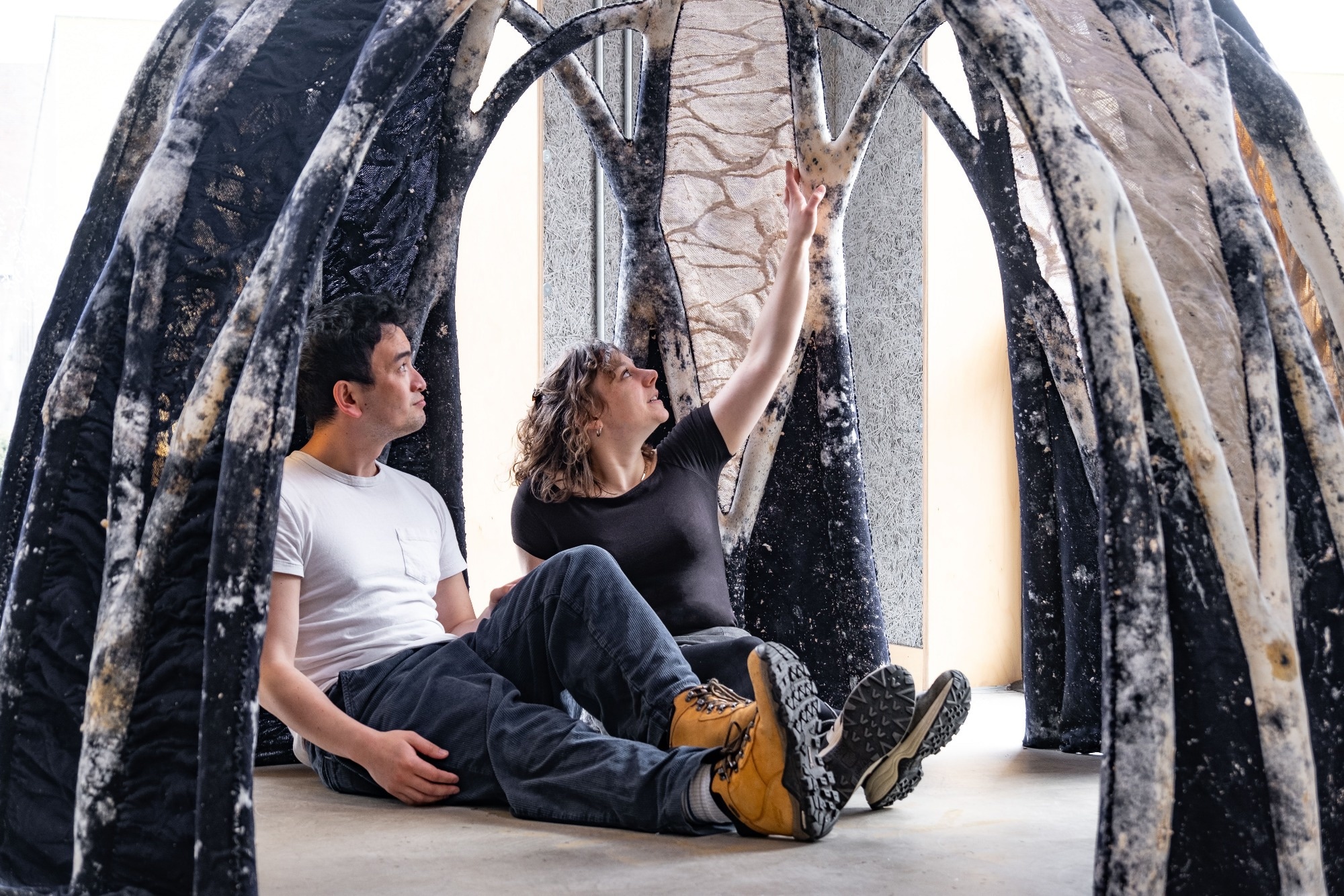Investigators have created mycocrete, a paste made with the root network of a fungus known as mycelium, as a building material. Injecting this into a knitted textile framework results in a composite material that is tougher and more adaptable than earlier fungi-based biomaterials and could ultimately be used to construct lightweight, low-impact buildings.

Image Credit: Hub for Biotechnology in the Built Environment
Researchers hoping to minimize the environmental impact of the construction industry have created a method for growing building materials using knitted molds and fungi’s root network.
Even though researchers have extensively experimented with similar composites, the organic material’s shape and growth constraints have made it challenging to create diverse applications that maximize its potential.
The researchers created a composite called “mycocrete” using the knitted molds as a flexible framework or “formwork,” boosting lightweight and comparatively eco-friendly construction materials.
Our ambition is to transform the look, feel, and wellbeing of architectural spaces using mycelium in combination with biobased materials such as wool, sawdust, and cellulose.
Dr. Jane Scott, Study Corresponding Author, Newcastle University
The study was published in the journal Frontiers in Bioengineering and Biotechnology.
The study was conducted by a team of engineers, designers, and scientists from Newcastle University’s Living Textiles Research Group, part of the Hub for Biotechnology in the Built Environment, funded by Research England.
Root Networks
Researchers combine mycelium spores with grains they can feed on and material they can grow on to create composites using mycelium, a component of fungi’s root network. This mixture is packed into a mold and positioned in a dark, humid, and warm environment, allowing the mycelium to grow and firmly bind to the substrate.
It is dried out once it has reached the proper density, but before it begins to produce the fruiting bodies known as mushrooms. This method could provide a low-cost, long-term replacement for foam, timber, and plastic. However, mycelium requires oxygen to grow, which restricts the size and shape of conventional rigid molds and, thus, their current applications.
Knitted textiles may provide a solution: oxygen-permeable molds that can change from flexible to stiff as the mycelium grows. However, textiles can be too yielding, making consistent mold packing difficult. Scott and her coworkers set out to create a mycelium mixture and a manufacturing system that could take advantage of the potential of knitted forms.
Knitting is an incredibly versatile 3D manufacturing system. It is lightweight, flexible, and formable. The major advantage of knitting technology compared to other textile processes is the ability to knit 3D structures and forms with no seams and no waste.
Dr. Jane Scott, Study Corresponding Author, Newcastle University
As controls, the researchers prepared samples of traditional mycelium composite and grew them alongside samples of mycocrete, which also housed paper fiber clumps, paper powder, glycerin, water, and xanthan gum. To enhance packing consistency, this paste was crafted to be delivered into the knitted formwork with an injection gun: the paste required to be liquid enough for the delivery system but not so liquid that it lost its shape.
Tubes for their intended test structure were knitted from merino yarn, sterilized, and fixed to a rigid structure while filled with the paste so that modifications in fabric tension would not impact mycocrete performance.
Building the Future
After drying, samples were subjected to tension, compression, and flexion strength tests. The mycocrete samples outperformed mycelium composites grown without knitted formwork and were highly durable than mycelium composite samples.
Furthermore, the porous knitted fabric of the formwork improved oxygen availability, and the samples grown in it shrank less when dried than most mycelium composite materials, implying that more reliable and stable manufacturing results could be achieved.
The group was also able to construct a greater proof-of-concept prototype structure called BioKnit—a complex freestanding dome crafted in a single piece without joins that might prove to be weak points, thanks to the flexible knitted form.
The mechanical performance of the mycocrete used in combination with permanent knitted formwork is a significant result, and a step towards the use of mycelium and textile biohybrids within construction. In this paper we have specified particular yarns, substrates, and mycelium necessary to achieve a specific goal. However, there is extensive opportunity to adapt this formulation for different applications. Biofabricated architecture may require new machine technology to move textiles into the construction sector.
Dr. Jane Scott, Study Corresponding Author, Newcastle University
Journal Reference:
Kaiser, R., et al. (2023). BioKnit: development of mycelium paste for use with permanent textile formwork. Frontiers in Bioengineering and Biotechnology. doi.org/10.3389/fbioe.2023.1229693.